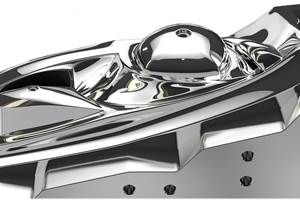Take the Guesswork Out of Mold Finishing with Micropolishing
A look at the value to the mold build process of a microscopic mold finishing process that uses ultrasonic polishing.
Share
Monday I woke up, and began my morning ritual. I took a shower, shaved, got dressed, had a little breakfast, went back in to the bathroom brushed my teeth, and then went to rinse. That is when I realized that there was a problem. As soon as the cold water hit my teeth it was like someone stabbed me in the gums.
I called the dentist, told them that I had a sharp pain way back in my last molar, typically a very difficult area to see or reach with flossing and brushing alone. Much to my horror they told me that they were booked till Friday. All week I tried to eat and drink out of the right side of my mouth and all week I experienced the pain that something is just not right. I would get something cold in the sensitive spot and it would stop me in my tracks.
When Friday finally came around and I got to the dentist he was quickly able to see the problem, he told me that I had a small cavity in a really bad spot, but not to worry he could fix it in no time. He leaned my chair back and told me to open up. That’s when I saw that he was wearing a blindfold and holding in his hand a Craftsman Professional 14.4 volt Cordless Drill/Driver with dual gear ranges, a 24-position adjustable torque clutch with ½-inch single sleeve keyless chuck, an automatic braking switch, and a bubble level on top. The handyman that I am, I instantly recognized that this was indeed a very nice drill for someone in the carpentry world, but absolutely the wrong tool in every way for this particular job.
Many of you have had this very same experience and don’t even know it. You see this is exactly what happens when you trust your high-tolerance parts to traditional mold finishing techniques. How many times have you gotten a job back and it looked great, only to find that maybe it was sticking in a certain difficult to hit area, or perhaps a critical edge was broken ever so slightly. These are your pains, these are your toothaches and just like with simple brushing and flossing, sometimes you need a little bit more, sometimes you need an exact precision clean part, and for this moldmakers need to investigate micropolishing.
Dissecting a Process
Micropolishing is a high detail mold finishing process that uses an ultrasonic polishing machine while looking through the lenses of a high powered stereo microscope, allowing the user the ability to see up to 18x more detail in your cores, cavities, pins and any other surface being treated.
Armed with a simple definition of micropolishing let’s dissect it a bit further starting with the importance of ultrasonic polishing. This process—which has been around since the late 1970s—works by generating high-frequency (ultrasonic) waves that are then transformed through the hand piece to create an extremely fast longitudinal reciprocation rate of 25,000 strokes per second of an abrasive tool. This coupled with the ability to control the stroke length form 4 to as little as 40 microns through the power output selector, allows for the most intricate and detailed polishing available to date.
Ultrasonic polishing ma-chines require the use of abrasive tools made from materials that are hard and strong in nature—such as plated diamond, solid diamond, abrasive stones, ceramic stones, as well as brass and wood laps. This strength requirement allows the user to apply more pressure to the job increasing the cutting action. These abrasive tools are also easily shaped to conform to the part or work surfaces allowing for a more precise finish.
This process is an extremely powerful, aggressive and controlled method of polishing, allowing the mold finishing professional distinct advantages over traditional practices (e.g., off hand or mechanical polishing). Ultrasonic polishing makes it possible for the operator to move the tool back and forth in a profiling at a rate of 25,000 strokes per second with the ability to set the stroke length between 4 to 40 microns. There is no other way to achieve the desired results on the most complex, highly detailed, close-tolerance jobs.
Over the years the main downfall to the ultrasonic polishing process was the fact that the user couldn’t actually see what they were doing; therefore, they were unsure of the amount of stock being removed, as well as you couldn’t be sure that you were in the exact right area. Like the blindfolded dentist, you had to trust your sense of judgment and hope to feel your way through the process. That coupled with the notion that ultrasonic polishing is a very aggressive method of mold finishing allows for the potential to remove too much material, possibly creating new problems on the most critical jobs. Going back to our dentist analogy, you have now turned a simple filling into a full-blown root canal, and no one likes that. With micropolishing the blindfold is removed, and in its place a high-powered stereomicroscope has been added.
In the past you could only fine-tune your settings and hope you were succeeding. Now with the microscope in place the polisher has the ability to focus directly onto the area on which they wish to work and see exactly what they are doing. Micropolishing takes the guesswork out of the polishing process, and in its place leaves confidence and precision craftsmanship.
This is not to say that micropolishing is a cure-all for every polishing job or that anyone can achieve these types of results. This process is most beneficial for close tolerance intricate work, dealing with complex configurations and should only be attempted by a trained professional.
A strong understanding of the job at hand, the ultrasonic machine and the polishing process is still an extremely important piece of the puzzle. Remember that just because you have the best tools, doesn’t mean you can necessarily do the job. I would take a trained dentist with the 14-volt Craftsman over my accountant neighbor with a full arsenal of the best dental equipment on the market.
Micropolishing—although not com-pletely full proof—is by far the best, most efficient way to treat your high precision jobs. There is no other process in the industry that is able to achieve both the power and control made possible through ultrasonic polishing, along with the ability to see exactly what you are doing through the use of a high powered stereomicroscope.
Related Content
What is Scientific Maintenance? Part 2
Part two of this three-part series explains specific data that toolrooms must collect, analyze and use to truly advance to a scientific maintenance culture where you can measure real data and drive decisions.
Read MoreHow to Achieve the Best Mold Finish
A look at factors that impact the polishability of tool steels and recommendations for obtaining a high-gloss finish.
Read MoreFour Micro Tooling Considerations
Issues involving gating, ejection, mold splits and direction of pull are of special concern when it comes to micro tooling.
Read MoreRead Next
The Value of a Shop’s Welding Policy
To put the appropriate welding policy in place, you need to choose the right welder—someone who is familiar with tool steel and has a working knowledge of molds.
Read More
















